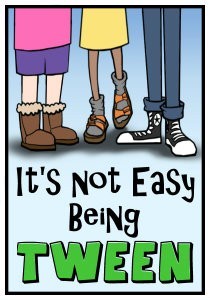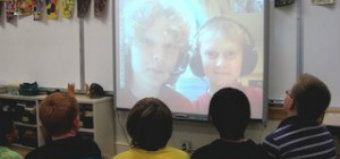8 Ways to Beat the Winter Doldrums
A MiddleWeb Blog

Sometimes, a classroom between deep winter and spring break can feel the same way. The shiny, new school year feeling has long worn off, the big holiday season excitement has waned, and we are all anxiously awaiting the season of rebirth and our next vacation.
I don’t want my class to start feeling like something the children need to get through between breaks. Although some find countdowns to vacation fun, I think nothing could be more demoralizing. If we are going to be here together, let’s brighten things up. I want, and need, that spring energy shot right now.
Todd Whitaker is a truly inspirational educator. In his book What Great Teachers Do Differently: 17 Things That Matter Most, Whitaker says, “One of the best things about being a teacher is that teaching matters and makes a difference, especially to the students. What makes teaching hard is that is matters EVERY DAY.” (emphasis added)

The following ideas are how I plan to keep my classroom energized in the weeks until spring break. I have used these before, and they really do make a difference—for the kids and for me. This list is by no means exhaustive, so feel free to share your own invigorating techniques.
1. Spread Positive Energy
Throughout the year, I like to send positive emails to parents about something wonderful I notice about their children. For the next couple of months, I am going to up the frequency of these, as well as shine a positive light on the students themselves. An unexpected and sincere “Well Done!” has the potential to turn around a dark day. They will be motivated to continue to do their best if they know I am noticing.
2. Inject Humor

We like Kid President for inspiration, but I don’t see the harm in a humorous movie or cartoon clip added to the mix. I had a middle school social studies teacher who used to show us video clips of “Football Follies” occasionally, and I remember the deep belly laughs and how it helped us recharge. We still learned in his class, but we loved him for giving us a mental holiday now and then.
3. Exercise the Brain
My school has student-chosen clubs twice a month. Each of the teachers chooses a club to develop and facilitate. Mine is called Brain Gym. A group of students comes to my classroom and works on brain teasers together. There is never an idle moment, and there’s lots of cheering when they solve the problems. Although I like to use inquiry techniques, it’s also fun to do language-based brain teasers as a class activity. I also like to incorporate art and music into our study of literature. We do close readings of photographs, paintings, and song lyrics. The students love it! Doing a novel critical-thinking activity increases their interest and energy level immediately.
4. Try Something New
I love the way professional development experiences can give my brain a jump start. I bring back new techniques and activities that I know my class will enjoy. They are fond of saying that my class is never boring because we do something different all the time. I like shaking things up to keep them on their toes.
I still have a couple of unseen ideas up my sleeve. Just wait until they see my March Madness brackets! We have routines and we have structure, but I don’t do the same activities every day. The very fact that they don’t know what to expect boosts their engagement with the material.
5. Connect with Others
My students love when we meet and share with another class—online or even in the same building. They get really excited to interact with someone new. This year, I want to work on some sort of pen pal program (I know it’s old school, but I love it), and I am hoping for an author visit or two as well. Whenever I am not the only audience for my students, they are reinvigorated to put their best foot forward.
6. Let Go of the Reins
I have written before about how I combine the Gradual Release of Responsibility technique with collaborative inquiry to get the students to stretch their brains. I have high expectations for what they can achieve and understand without my interference – and they rarely disappoint.
My classes have already completed their first Passion Projects and presented them before winter break, but I have received numerous requests (even from the parents) for a second round this spring. Their wish is my command. I have other opportunities for them to take over the class too. For example, they will begin running their own book club discussions and presenting book talks.
7. Get Active
Throughout the year, I find teaching in short chunks, incorporating brain breaks, and working in groups to be very effective. Getting students out of their seats and moving makes a huge difference this time of year when many of us in cold-weather climates are not getting as much outdoor activity to expend our energy. These are the days when “pass the preposition pig” and other such silly games do the most to help give us that extra jolt we need.
8. Out with the Old; In with the New
Just as I do spring cleaning at home, I also do it at school. Nothing feels better than organizing files, dusting bookshelves, and rotating displays. It sound weird, but somehow cleaning the cobwebs from the corners of my room removes them from my brain as well. This works the same way for the children. When I allow them to clean and organize their work and work space, it makes them feel ready to tackle the new task at hand. Doing this in anticipation of spring is another way to rev ourselves up for tomorrow and all the days ahead.
I am sure there are many other ways to revitalize classrooms, and I will have fun gathering more ideas. I will make every day matter.





































What is the game referred to here as “pass the preposition pig”.
Instead of handing out a page of boxes located in different configurations labeled with prepositions (as I have seen online), I have a small stuffed pig that we toss from person to person and each child must state the pig’s location using a different prepositional phrase. For example, the pig is under the desk. Toward the end, we can determine how to use the non spatial ones such as “the pig is the son OF Kermit and Miss Piggy.”